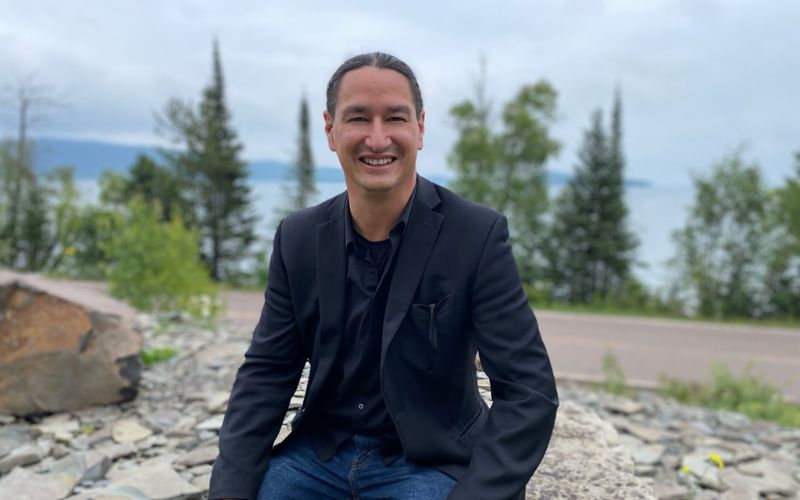
- Details
- By Kaili Berg
The book, slated for official release on September 2, 2024, is designed for children aged 6 to 11, blending storytelling with educational content to introduce key Ojibwe words and phrases.
The narrative follows a young boy as he learns about the significance of the dreamcatcher, a powerful symbol in Ojibwe culture, from his family. Through this lens, readers are invited into a day in the life of an Ojibwe family, experiencing their customs, language, and traditions.
One of the highlights of Wisdom Weavers is the culturally accurate how-to guide for making a dream catcher at home. This practical component not only educates readers about the cultural significance of the Dreamcatcher but also encourages hands-on learning and connection to the tradition.
Vukelich Kaagegaabaw is an internationally recognized speaker, author, and advocate for Indigenous language preservation. His work, particularly the popular Ojibwe Word of the Day, has been instrumental in promoting the Ojibwe language to a global audience.
With Wisdom Weavers, Vukelich Kaagegaabaw continues his mission to preserve and share the culture of the Ojibwe people, making it accessible to young readers everywhere.
Wisdom Weavers will be available for purchase starting September 3, 2024. Educators, parents, and anyone interested in Indigenous languages and cultures are encouraged to explore the book.
Native News Online spoke with Vukelich Kaagegaabaw about being inspired by teaching his son Ojibwe traditions during the pandemic, the importance of teaching Indigenous languages to children, and what projects he has on the horizon.
How did you become interested in the Ojibwe language?
I became interested in the Ojibwe language when I was around 25. I had the chance to take a course at Minneapolis Community and Technical College, and I became absolutely fascinated with it. Until that point, I had not heard the language, even though I had studied French, a bit of Italian, and some Latin. Hearing Ojibwe for the first time was truly eye-opening for me.
Can you share the inspiration behind Wisdom Weavers? What motivated you to create this book specifically for young readers?
The idea for Wisdom Weavers came during the pandemic. I was at home with my son, and I wanted to teach him about our traditions. I thought it would be cool to show him how to make a dreamcatcher.
Later, he mentioned that they were talking about dream catchers in his class, and I realized it was a great opportunity to share the Ojibwe name and words associated with this cultural item. The book is a way to share that with younger readers and introduce them to the language and heritage.
The book features a culturally accurate guide to making a dreamcatcher. Can you talk about the significance of the dream catcher in Ojibwe culture?
The dreamcatcher is traditionally made for babies. When my son was a child, I made one for him and hung it from his cradleboard. The dreamcatcher is like a net that catches bad dreams while letting good dreams pass through the central hole. It’s a symbol of protection and positivity.
The book introduces 73 words and phrases in Ojibwe. How did you select those words, and what role do they play in daily Ojibwe life?
The book is like a day in the life of a young mixed child. The words are common items that children everywhere might encounter. I recorded all the words so readers could hear them pronounced correctly using their phones. Each page has a QR code. When scanned, it plays the pronunciation of the word. It’s a great tool for anyone learning Ojibwe with their child or in a classroom.
Can you discuss the importance of teaching Indigenous languages to children at a young age? How do you believe Wisdom Weavers can contribute to this goal?
Teaching Indigenous languages to children is crucial, especially since many kids, like mine, have little to no exposure to their Native language, culture, or spirituality.
Wisdom Weavers is an introduction to the Ojibwe language—a way to spark interest and provide a glimpse into a beautiful, sophisticated way of thinking. Language is a fundamental part of identity and our relationship with the world, and I hope this book helps foster that connection for the next generation.
What has been the response to Wisdom Weavers so far? Have there been any particular moments of feedback that have stood out to you?
The response has been really enthusiastic. People appreciate seeing the culture represented in a children’s book, and the language component has been especially well-received. Many enjoy using the QR codes to hear the words pronounced.
What do you see as the next steps in your journey of promoting the Ojibwe language and culture? Are there any upcoming projects you’re excited about?
I’m currently working on another book and a keynote on well-being through the lens of the Ojibwe language. I’m also putting together a collection from my Ojibwe Word of the Day series. These will be aimed more at middle schoolers through adults.
For parents and educators who may not be familiar with the Ojibwe language, what advice would you give them on how to use Wisdom Weavers as a tool for teaching their children?
I hope they enjoy it first and foremost. Learning is most effective when it’s fun. Approach it as a learner, and enjoy the process. I’ve done a lot of the legwork with the recordings to make them accessible. I hope it serves as an introduction to the beautiful aspects of Ojibwe culture and language.
More Stories Like This
Watermark Art Center to Host “Minwaajimowinan — Good Stories” ExhibitionMuseums Alaska Awards More Than $200,000 to 12 Cultural Organizations Statewide
Zuni Youth Enrichment Project Takes Top Emerging Artist Apprentices to Phoenix for Artistic Exploration and Cultural Immersion
From Dishwasher to Award-Winning Chef: Laguna Pueblo's Josh Aragon Serves Up Albuquerque's Best Green Chile Stew
Rob Reiner's Final Work as Producer Appears to Address MMIP Crisis
Help us defend tribal sovereignty.
At Native News Online, our mission is rooted in telling the stories that strengthen sovereignty and uplift Indigenous voices — not just at year’s end, but every single day.
Because of your generosity last year, we were able to keep our reporters on the ground in tribal communities, at national gatherings and in the halls of Congress — covering the issues that matter most to Indian Country: sovereignty, culture, education, health and economic opportunity.
That support sustained us through a tough year in 2025. Now, as we look to the year ahead, we need your help right now to ensure warrior journalism remains strong — reporting that defends tribal sovereignty, amplifies Native truth, and holds power accountable.
 The stakes couldn't be higher. Your support keeps Native voices heard, Native stories told and Native sovereignty defended.
The stakes couldn't be higher. Your support keeps Native voices heard, Native stories told and Native sovereignty defended.
Stand with Warrior Journalism today.
Levi Rickert (Potawatomi), Editor & Publisher


